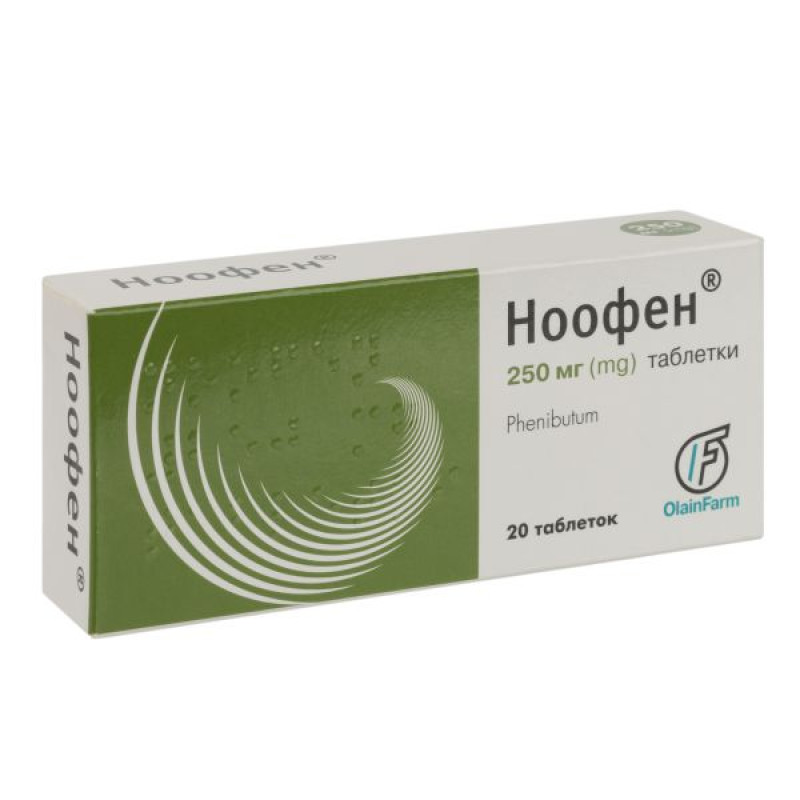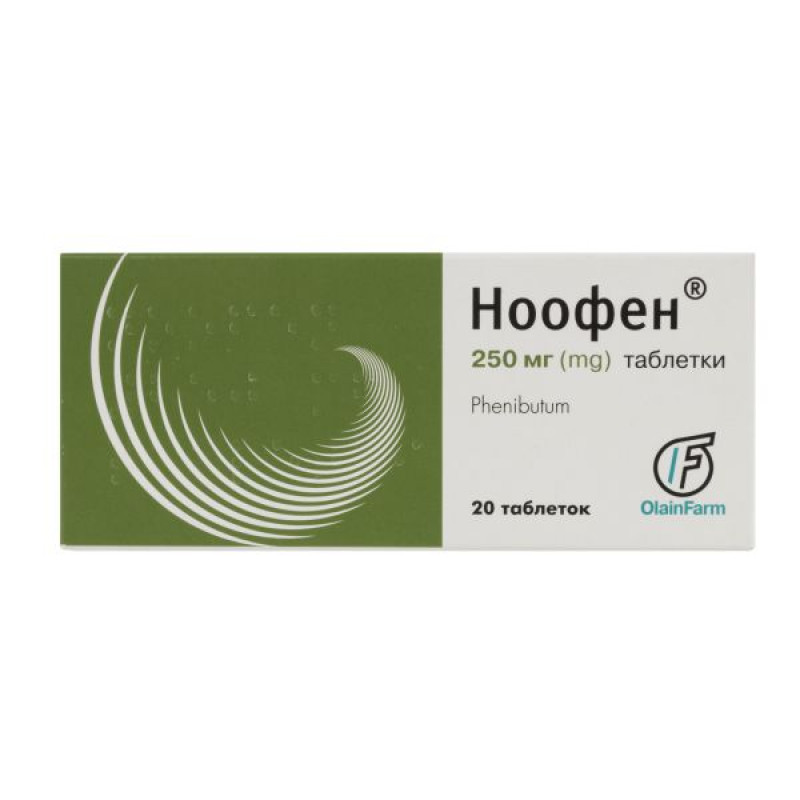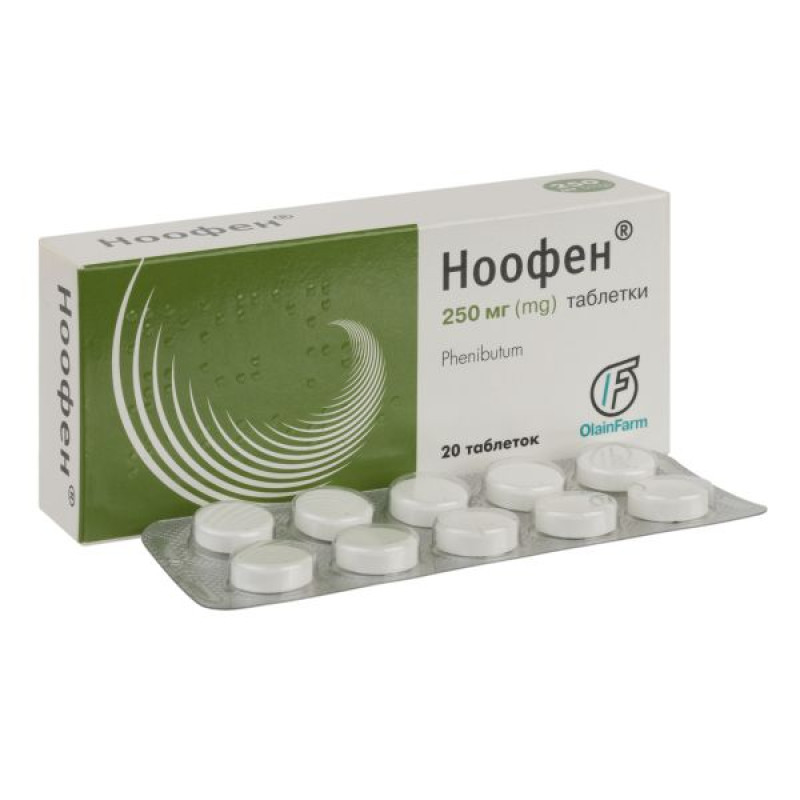Noofen tablets 250 mg blister No. 20

Instructions Noofen tablets 250 mg blister No. 20
Composition
active ingredient: phenibut;
1 tablet contains phenibut 250 mg;
Excipients: lactose monohydrate; corn starch; pregelatinized modified corn starch; stearic acid.
Dosage form
Pills.
Main physicochemical properties: flat-cylindrical tablets from white to white with a yellowish tint, with a bevel and a score on one side.
Pharmacotherapeutic group
Other psychostimulants and nootropics.
ATX code N06B X22.
Pharmacological properties
Pharmacodynamics
Noofen® is a derivative of γ-aminobutyric acid (GABA) and phenylethylamine.
Its dominant action is antihypoxic and antiamnestic. Noofen® improves memory and attention, promoting learning processes, increases physical and mental performance. Psychological indicators (attention, memory, speed and accuracy of sensory-motor reactions) under the influence of Noofen® improve. It has been established that Noofen® increases the energy potential of the neuron by improving the functions of mitochondria.
Noofen® also has tranquilizer properties: it eliminates psychoemotional tension, anxiety, fear, emotional lability, irritability, improves sleep, prolongs and enhances the effect of hypnotics, narcotics, neuroleptics and anticonvulsants. Noofen® binds in the brain exclusively to GABA-ß receptors, therefore it exhibits a moderate sedative effect, but does not cause undesirable sedative effects: drowsiness, dizziness, decreased attention and performance. The drug prolongs the latent period and reduces the duration and severity of nystagmus, has an antiepileptic effect. It does not affect cholinergic and adrenoreceptors.
Noofen® significantly reduces the manifestations of asthenia and vasovegetative symptoms, including headache, feeling of heaviness in the head. In patients with asthenia and in emotionally labile individuals, the use of Noofen® improves well-being without excitement.
Pharmacokinetics
Absorption and distribution
The drug is well absorbed after oral administration and penetrates well into all tissues of the body, passes well through the blood-brain barrier (about 0.1% of the administered dose of the drug penetrates into the brain tissue, and in young and elderly people it is much higher). The greatest binding of phenibut occurs in the liver (80%), it is non-specific.
Biotransformation and excretion
80-95% of phenibut is metabolized in the liver, the metabolites are pharmacologically inactive.
Distribution in the liver and kidneys is close to uniform, and in the brain and blood - less uniform. After 3 hours, a noticeable amount of the administered phenibut is detected in the urine, while the concentration of the drug in the brain tissue does not decrease - it is detected in the brain for another 6 hours. The next day, phenibut can only be detected in the urine; it is found in the urine for another 2 days after administration, but the detected amount is only 5% of the administered dose. Cumulation is not observed with repeated administration.
Indication
Asthenic and anxiety-neurotic states: restlessness, fear, anxiety.
Insomnia, nighttime restlessness in the elderly.
Prevention of stressful conditions before surgeries or painful diagnostic tests.
Meniere's disease, dizziness associated with dysfunction of the vestibular analyzer of various origins.
Prevention of motion sickness (a specific condition characterized by nausea, vomiting, prostration, and vestibular dysfunction caused by being in a moving object, such as a ship or airplane).
Stuttering, tics in children aged 8 to 14 years.
As an adjunct in the treatment of alcohol withdrawal syndrome.
Contraindication
Hypersensitivity to the components of the drug.
Acute renal failure.
Pregnancy and breastfeeding.
Interaction with other medicinal products and other types of interactions
Noofen® can be combined with psychotropic drugs, reducing the doses of Noofen® and the drugs used with it.
Noofen® enhances and prolongs the effect of hypnotics, narcotics, neuroleptics, and anti-Parkinsonian drugs.
Application features
The drug should be used with caution in patients with stomach or intestinal pathology. To protect the mucous membrane from the irritating effects of phenibut, these patients are prescribed lower doses.
In case of long-term treatment, blood and liver parameters should be monitored.
The medicinal product contains lactose, therefore patients with rare hereditary forms of galactose intolerance, lactase deficiency or glucose-galactose malabsorption syndrome should not take it.
Ability to influence reaction speed when driving vehicles or other mechanisms
Patients who experience drowsiness, dizziness, or other central nervous system disorders during treatment with the drug should refrain from driving or operating other mechanisms.
Use during pregnancy or breastfeeding
Animal studies have not revealed any mutagenic, teratogenic or embryotoxic effects of phenibut. There are no adequate and well-controlled studies on the safety of phenibut in pregnant women. Therefore, the use of Noofen® during pregnancy or breastfeeding is contraindicated.
Method of administration and doses
Noofen® is taken orally before meals. The tablet is swallowed whole with a sufficient amount of water.
For asthenic and anxiety-neurotic conditions, adults are prescribed 250-500 mg (1-2 tablets) 3 times a day. The highest single doses: for adults - 750 mg, for elderly patients - 500 mg.
The course of treatment is 2-3 weeks. If necessary, the course of treatment can be extended to 4-6 weeks.
Children aged 8 to 14 years should be prescribed 250 mg (1 tablet) 3 times a day.
Noofen®, 250 mg capsules can be used as an alternative dosage form.
The course of treatment is 2−6 weeks.
Meniere's disease, dizziness associated with dysfunction of the vestibular apparatus of various origins.
In case of vestibular dysfunction of infectious origin and Meniere's disease during the period of exacerbation, Noofen® is prescribed at 750 mg (3 tablets) 3 times a day for 5-7 days, with a decrease in the severity of vestibular disorders - at 250-500 mg (1-2 tablets) 3 times a day for 5-7 days, and then at 250 mg 1 time a day for 5 days. In case of relatively mild diseases, Noofen® is used at 250 mg (1 tablet) 2 times a day for 5-7 days, and then at 250 mg 1 time a day for 7-10 days.
To eliminate dizziness in vestibular dysfunctions of vascular and traumatic genesis, Noofen® is prescribed at 250 mg 3 times a day for 12 days.
To prevent motion sickness, the drug is taken at a dose of 250-500 mg once, one hour before the expected onset of motion sickness or at the first symptoms of motion sickness.
To relieve alcohol withdrawal syndrome, Noofen® is prescribed in the first days of treatment at 250-500 mg 3 times a day and 750 mg at night, with a gradual decrease in the daily dose to the usual adult dose.
Patients with hepatic insufficiency
In patients with hepatic insufficiency, high doses of the drug may cause hepatotoxicity. Lower doses are prescribed to this group of patients.
Patients with renal insufficiency
There are no data on the adverse effects of Noofen® on patients with impaired renal function when taking therapeutic doses.
No development of drug dependence or withdrawal syndrome was observed during the use of this medicinal product.
Isolated cases of tolerance to phenibut can be found in literary sources.
Children
The drug can be used in children aged 8 years and older.
Overdose
Noofen® is a low-toxic drug: only at a daily dose of 7-14 g, in case of prolonged use, it can be hepatotoxic. There are no data on overdose.
The indicated doses significantly exceed the recommended dose (the average therapeutic dose is 500−2000 mg).
Symptoms: drowsiness, nausea, vomiting, dizziness.
With prolonged use of high doses, the development of arterial hypotension, acute renal failure, eosinophilia and fatty liver disease is possible.
Treatment: gastric lavage. Symptomatic therapy.
There is no specific antidote.
Adverse reactions
Noofen®, like all medicines, can cause side effects, although not everybody gets them.
Classification of adverse reactions by frequency of development: very common (≥ 1/10); common (≥ 1/100 to < 1/10); uncommon (≥ 1/1000 to < 1/100); rare (≥ 1/10,000 to < 1/1000); very rare (< 1/10,000); frequency unknown (cannot be estimated from the available data).
Nervous system: frequency unknown - drowsiness (at the beginning of treatment), headache and dizziness (in doses above 2 g per day, with a decrease in the dose, the severity of the side effect decreases).
Gastrointestinal: frequency unknown - nausea (at the beginning of treatment), vomiting, diarrhea, epigastric pain.
Liver and biliary tract: frequency unknown - hepatotoxicity (with prolonged use of high doses).
Immune system disorders: frequency unknown - hypersensitivity reactions, including urticaria, erythema, rash, angioedema, facial edema, tongue edema.
Skin and subcutaneous tissue disorders: rarely - allergic reactions (rash, itching).
Mental disorders: frequency unknown - emotional lability, sleep disorders (these adverse reactions may occur in children if the instructions for use are not followed).
If during treatment you experience side effects not listed in this manual, or if any of the listed side effects are particularly severe, please consult a doctor.
Expiration date
4 years.
Storage conditions
Store in the original packaging at a temperature not exceeding 25 °C.
Keep out of reach of children.
Packaging
10 tablets in a blister. 2 blisters in a cardboard pack.
Vacation category
According to the recipe.
Producer
JSC "Olinepharm".
Location of the manufacturer and its business address
Rupniču Street 5, Olaine, LV-2114, Latvia.
There are no reviews for this product.
There are no reviews for this product, be the first to leave your review.
No questions about this product, be the first and ask your question.










